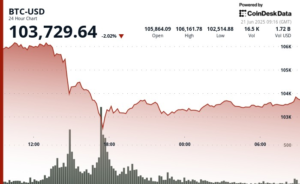One activist investor has bold plans for
UBS,
saying that the Swiss bank could soon resemble the Wall Street titan
Morgan Stanley.
Cevian Capital said Tuesday it has taken a $1.3 billion stake in UBS, amounting to 1.3% of the company. The move comes nine months after UBS was forced to acquire rival Credit Suisse as a result of the banking turmoil this past spring.
UBS shares have risen 62% so far this year as it folds Credit Suisse into its operations. But Cevian sees room for more.
“Cevian sees significant value potential in UBS. The board and management team are doing an excellent job integrating Credit Suisse and we have been impressed by their commitment to further improve UBS,” Lars Förberg, co-founder of Cevian, said Tuesday.
“Strengthened by the acquisition, UBS is the largest global wealth manager with unique market positions and financial strength. If the valuation gap to Morgan Stanley at 2x price to tangible book is closed, the UBS share is worth CHF 50 ($58.10),” Förberg added. UBS currently trades at 1.2 times tangible book value.
UBS declined to comment on Cevian’s stake. The bank is in the midst of a preparing three-year integration plan tied to its acquisition of Credit Suisse.
Shares of UBS were 4% higher on Tuesday.
It is easy to see why Morgan Stanley would be the envy of other banks. While Morgan Stanley struggled to make it through the 2008-2009 financial crisis, it smartly pivoted afterward to focus more on wealth management than on trading and investment banking.
It wasn’t a move without hiccups and skepticism, but now, 15 years after the crisis, more than half of Morgan Stanley’s revenue is derived from wealth and investment management. Both businesses bring in fee-based revenue that is more consistent than the volatile returns trading and investment banking offer.
Over the past 15 years, Morgan Stanley’s shares have climbed more than 400%, while the KBW Nasdaq Bank Index has advanced a little more than 100%.
As of the third quarter, UBS derived 56% of its revenue from wealth and asset management, compared with 52% at Morgan Stanley. But although it has a hefty footprint in the U.S., its valuation is more in line with European peers than U.S. banks.
The discount for European lenders can be attributed to myriad factors, including Europe coming back from the aftermath of negative interest rates and the fact that Continental banks are often less aggressive on dividends and buybacks than their U.S. peers. During the pandemic, the European Central Bank called on banks under its supervision to freeze dividends, whereas U.S. regulators only issued a cap on the payouts.
UBS has the pieces in play to be a Morgan Stanley rival, but putting them together will be slow and complicated.
Write to Carleton English at carleton.english@dowjones.com
Read the full article here










